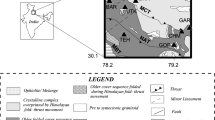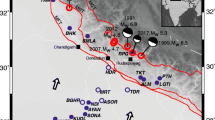Abstract
The destructive Mw = 7.8 Nepal earthquake happened in Nepal Himalaya, 80 km NW of Kathmandu city on 25 April 2015. A number of aftershocks in which one of them is Mw = 7.3 which occurred on 12 May 2015 are observed around the Kathmandu city of Nepal. In this paper, strong motion data of Nepal earthquake and its eight aftershocks having magnitude range 5.3–7.3, recorded at Kathmandu station is used to determine site effects and attenuation factor. Kathmandu city, capital of Nepal, is situated in a valley which consists of sediments of more than 300 m depth. Hence strong motion data recorded at Kathmandu station is strongly affected by site effect and anelastic attenuation. In this work, S-phase spectra recorded at Kathmandu station are corrected for site effect and anelastic attenuation to compute the source parameters of the events. The site effects and anelastic attenuation are estimated from inversion of strong motion data by using the inversion technique suggested by Joshi (Bull Seismol Soc Am 96:2165–2180, 2006a). The shear wave quality factor (Q β (f)) is computed at Kathmandu station by using the inversion scheme as Q β (f) = 68f0.58. The site effects and attenuation factor obtained by inversion technique are used to correct the spectrum for site effect and anelastic attenuation. The corrected source spectrum is compared with theoretical (Brune in J Geophys Res 78:4997–5009, 1970) spectrum to estimate various source parameters. Both horizontal component (North–South and East–West) are utilized to estimate the source parameters of 25 April 2015 Mw = 7.8 Nepal earthquake and its aftershocks. The best-fit theoretical spectrum provides final values of source parameters, i.e., stress drop, seismic moment, and source radius as 48.7 bars, 5.96 × 1027 dyne cm and 37.75 km, respectively, for the 25 April 2015 Mw = 7.8 earthquake and 1.40 × 1027 dyne cm, 44.7 bars, and 23.90 km, respectively, for the 12 May 2015 Mw = 7.3 earthquake.













Similar content being viewed by others
References
Aki K (1967) Scaling law of seismic spectrum. J Geophys Res 72:1217–1231
Aki K, Richards PG (1980) Quantitative Seismology: Theory and Methods. W. H. Freeman and Co., New York
Aki K, Richards PG (2002) Quantitative seismology, 2nd edn. University Science Books, Sausalito
Atkinson GM, Boore DM (1995) Ground-motion relation for eastern North America. Bull Seismol Soc Am 85:17–30
Atkinson GM, Boore DM (1998) Evaluation of models for earthquake source spectra in eastern North America. Bull Seismol Soc Am 88:917–934
Bhat GM, Pandita SK, Singh Y, Sharma S (2013) Estimation of source parameters of local earthquakes in Jammu and Kashmir, India. Int J Sci Res 3(2):1–5
Bhattacharya AR (2008) Basement rocks of the Kumaun-Garhwal himalaya: implications for Himalayan tectonics. J Earth Sci India I(I):1–10
Boore DM (1983) Stochastic simulation of high frequency ground motion based on seismological models of radiated Spectra. Bull Seismol Soc Am 73:1865–1894
Boore DM, Atkinson GM (1987) Stochastic prediction of ground motion and spectral response parameters at hard-rock sites in eastern North America. Bull Seismol Soc Am 77:440–467
Boore DM, Bommer JJ (2005) Processing of strong motion accelerograms: needs, options and consequences. Soil Dyn and Earthq Eng 25:93–115
Brune JM (1970) Tectonic stress and spectra of seismic shear waves from earthquakes. J Geophys Res 75:4997–5009
Brune JN (1971) Correction. J Geophys Res 76:5002
Coleman M, Hodges K (1995) Evidence for Tibetan plateau uplift before 14 Myr ago from a new minimum age for east-west extension. Nature 374:49–52
Denolle MA, Fan W, Shearer PM (2015) Dynamics of the 2015 M7.8 Nepal earthquake. Geophys Res Lett. https://doi.org/10.1002/2015GL065336
Fletcher JB (1995) Source parameters and crustal Q for four earthquakes in South Carolina. Seismol Res Lett 66:44–58
Hadley DM, Helmberger DV (1980) Simulation of ground motions. Bull Seismol Soc Am 70:610–617
Hadley DM, Helmberger DV, Orcutt JA (1982) Peak ground acceleration scaling studies. Bull Seismol Soc Am 72:959–978
Hanks TC, Kanamori H (1979) A moment magnitude scale. J Geophys Res 84(B5):2348–2350
Hanks TC, McGuire RK (1981) The character of high frequency ground motion. Bull Seismol Soc Am 71:2071–2095
Hartzell SH (1978) Earthquake aftershocks as Green’s functions. Geophys Res Lett 5:1–4
Hazarika P, Kumar MR, Kumar D (2013) Attenuation character of seismic waves in Sikkim Himalaya. Geophys J Int 195:544–557
Housner GW, Jennings PC (1964) Generation of artificial earthquakes. Proc Am Soc Civil Eng 90:113–150
Joshi A (2006a) Use of acceleration spectra for determining the frequency dependent attenuation coefficient and source parameters. Bull Seismol Soc Am 96:2165–2180
Joshi A (2006b) Analysis of strong motion data of the Uttarkashi earthquake of 20th October 1991 and the Chamoli earthquake of 28th March 1999 for determining the mid crustal Q value and source parameters. J Earthq Technol 43:11–29
Joshi A, Kumar P, Mohanty M, Bansal AR, Dimri VP, Chadha RK (2012) Determination of Q β (f) at different places of Kumaon Himalaya from the inversion of spectral acceleration data. Pure appl Geophys 169:1821–1845
Joshi A, Kumar P, Arora S (2014) Use of site amplification and anelastic attenuation for the determination of source parameters of the Sikkim earthquake of September 18, 2011, using far-field strong-motion data. Nat Hazards 70:217–235
Katel TP, Upreti BN, Pokharel GS (1996) Engineering properties of fine grained soils of Kathmandu Valley Nepal. J Nepal Geol Soc 13:121–138
Ko YT, Kuo BY, Hung SH (2012) Robust determination of earthquake source parameters and mantle attenuation. J Geophys Res 117:B04304. https://doi.org/10.1029/2011JB008759
Kumar D, Sarkar I, Sri Ram V, Khattri KN (2005) Estimation of the source parameters of the Himalaya earthquake of October 19, 1991, average effective shear wave attenuation parameter and local site effects from accelerograms. Tectonophysics 407:1–24
Kumar A, Kumar A, Gupta SC, Mittal H, Kumar R (2013) Source parameters and f max in Kameng region of Arunachal Lesser Himalaya. J Asian Earth Sci 70–71:35–44
Kumar P, Joshi A, Sandeep Kumar A, Chadha RK (2015) Detailed attenuation study of shear waves in the Kumaon Himalaya, India, using the inversion of strong-motion data. Bull Seismol Soc Am 105(4):1836–1851
Kuo CH, Wen KL, Hsieh HH, Lin CM, Chang TM, Kuo KW (2012) Site classification and Vs30 estimation of free-field TSMIP stations using the logging data of EGDT. Eng Geol 129–130:68–75
Leonard M (2010) Earthquake fault scaling: self-consistent relating of rupture length, width, average displacement, and moment release. Bull Seismol Soc Am 100(5A):1971–1988
Lermo J, Chávez-García F (1993) Site effect evaluation using spectral ratios with only one station. Bull Seismol Soc Am 83:1574–1594
Luzon F, Gil-Zepeda SA, Sanchez-Sesma FJ, Ortiz-Aleman C (2004) Three-dimensional simulation of ground motion in the Zafarraya Basin (Southern Spain) up to 1.335 Hz under incident plane waves. Geophys J Int 156(3):584–594
Madariaga R, Ruiz S (2016) Earthquake dynamics on circular faults: a review 1970–2015. J Seismol 20:1235–1252
Mitra S, Paul H, Kumar A, Singh SK, Dey S, Powali D (2015) The 25 April 2015 Nepal earthquake and its aftershocks. Curr Sci 108(10):1938–1943
Mittal H, Kumar A (2015) Stochastic finite fault modeling of Mw 5.4 earthquake along Uttarakhand-Nepal border. Nat Hazards 75(2):1145–1166
Mittal H, Kumar A, Kamal (2013) Ground motion estimation in Delhi from postulated regional and local earthquakes. J Seismol 17(2):593–605
Mittal H, Wu YM, Chen DY, Chao WA (2016) Stochastic finite modelling of ground motion for March 5th 2012 Mw 4.6 earthquake and scenario greater magnitude earthquake in the proximity of Delhi. Nat Hazards 82(2):1123–1146
Nath SK, Vyas M, Pal I, Singh AK, Mukherjee S, Sengupta P (2005) Spectral attenuation models in the Sikkim Himalaya from the observed and simulated strong motion events in the region. Curr Sci 88(2):295–303
Ni J, Barazangi M (1984) Seismotectonics of the Himalayan Collision Zone: geometry of the Underthrusting Indian Plate beneath the Himalaya. J Geophys Res 89:1147–1163
Papageorgiou A, Aki K (1983) A specific barrier model for the quantitative description of inhomogeneous faulting and the prediction of strong ground motion, Part 1. Description of the model. Bull Seismol Soc Am 73:693–722
Parshad R, Rani S, Ghangas V, Kumar A, Rana V, Joshi P, Shrivastva PK, Ganju A (2014) Source parameters of local earthquakes in Nubra region, NW Himalaya. Int J Adv Res 2(8):151–158
Paudyal YR, Yatabe R, Bhandary NP, Dahal RK (2013) Basement topography of the Kathmandu Basin using microtremor observation. J Asian Earth Sci 62:627–637
Ruff LJ (1999) Dynamic stress drop of recent earthquakes: variations within subduction zones. Pure appl Geophys 154(1999):409–431
Sakai H, Fujii R, Kuwahara Y (2002) Changes in the depositional system of the Paleo-Kathmandu Lake caused by uplift of the Nepal Lesser Himalayas. J Asian Earth Sci 20:267–276
Seeber L, Armbruster JG (1984) Some elements of continental subduction along the Himalayan front. Tectonophysics 92:335–367
Shanker D, Paudyal H, Singh HN (2011) Discourse on seismotectonics of Nepal Himalaya and vicinity: appraisal to earthquake hazard. Geosciences 1(1):1–15
Sharma ML, Wason HR (1994) Occurrence of low stress drop earthquakes in the Garhwal Himalaya region. Phys Earth Planet Inter 34:159–172
Singh SK, Ordaz M, Dattatrayam RS, Gupta HK (1999) A spectral analysis of the 21 May 1997, Jabalpur, India, earthquake (M w = 5:8) and estimation of ground motion from future earthquakes in the Indian shield region. Bull Seismol Soc Am 89:1620–1630
Wells LD, Coppersmith KJ (1994) New empirical relationships among magnitude, rupture length, rupture width, rupture area and surface displacement. Bull Seismol Soc Am 84:974–1002
Yin A, Harrison TM (2000) Geologic evolution of the Himalayan-Tibetan orogen. Annu Rev Earth Planet Sci 28:211–280
Acknowledgements
The authors wish to thank the Director, Wadia Institute of Himalayan Geology, Dehradun, for providing permission to publish and supporting this research work. Editor in Chief: T. Glade, Associate Editor, and two anonymous reviewers are highly acknowledged for beneficial suggestions and significant review. The strong motion data obtained from http://earthquake.usgs.gov is thankfully acknowledged.
Author information
Authors and Affiliations
Corresponding author
Rights and permissions
About this article
Cite this article
Kumar, P., Joshi, A., Kumar, S. et al. Determination of site effect and anelastic attenuation at Kathmandu, Nepal Himalaya region and its use in estimation of source parameters of 25 April 2015 Nepal earthquake Mw = 7.8 and its aftershocks including the 12 May 2015 Mw = 7.3 event. Nat Hazards 91, 1003–1023 (2018). https://doi.org/10.1007/s11069-018-3178-2
Received:
Accepted:
Published:
Issue Date:
DOI: https://doi.org/10.1007/s11069-018-3178-2




